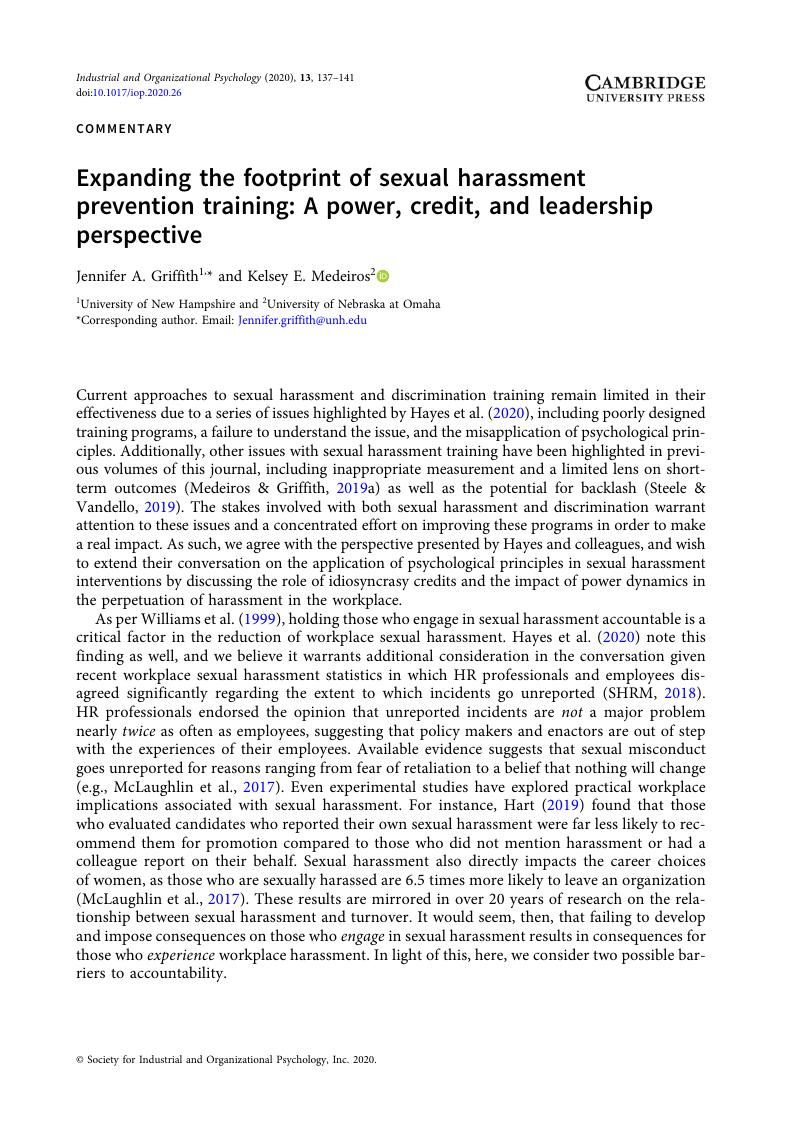No CrossRef data available.
Article contents
Expanding the footprint of sexual harassment prevention training: A power, credit, and leadership perspective
Published online by Cambridge University Press: 28 July 2020
Abstract
An abstract is not available for this content so a preview has been provided. Please use the Get access link above for information on how to access this content.

- Type
- Commentaries
- Information
- Copyright
- © Society for Industrial and Organizational Psychology, Inc. 2020
References
Akinola, M., Georgia, O., Mayer, D., Ruttan, R. L., & Williams, J. (2018). Business or fairness case for social issues? Influencing stakeholders in organizations. In Academy of Management Proceedings (Vol. 2018, No. 1, p. 14510). Briarcliff Manor, NY: AOM.Google Scholar
Baldwin, T. T., & Ford, J. K. (1988). Transfer of training: A review and directions for future research. Personnel Psychology, 41, 63–105.CrossRefGoogle Scholar
Banyard, V. L., Plante, E. G., & Moynihan, M. M. (2004). Bystander education: Bringing a broader community perspective to sexual violence prevention. Journal of Community Psychology, 32(1), 61–79.CrossRefGoogle Scholar
Bauer, M., & Ramirez, M. (2010). Injustice on our plates: Immigrant women in the U.S. food Industry. Southern Poverty Law Center. Retrieved from https://web.archive.org/web/20191121055037/https://www.splcenter.org/20101107/injustice-our-platesGoogle Scholar
Bowes-Sperry, L., & O’Leary-Kelly, A. M. (2005). To act or not to act: The dilemma faced by sexual harassment observers. Academy of Management Review, 30(2), 288–306.CrossRefGoogle Scholar
Burke, L. A., & Hutchins, H. M. (2007). Training transfer: An integrative literature review. Human Resource Development Review, 6(3), 263–296.CrossRefGoogle Scholar
Feldblum, C., & Lipnic, V. (2016). EEOC Select Task Force on the Study of Harassment in the Workplace, report of Co-Chairs Chai R. Feldblum and Victoria A. Lipnic. Retrieved from https://www.eeoc.gov/eeoc/task_force/harassment/report.cfmGoogle Scholar
Hart, C. G. (2019). The penalties for self-reporting sexual harassment. Gender & Society, 33(4), 534–559.CrossRefGoogle Scholar
Hayes, T. L., Kaylor, L. E., & Oltman, K. A. (2020). Coffee and controversy: How applied psychology can revitalize sexual harassment and racial discrimination training. Industrial and Organizational Psychology: Perspectives on Science and Practice, 13(2), XXX–XXX.CrossRefGoogle Scholar
Hegewisch, A., & O’Farrell, B. (2015). Women in the construction trades: Earnings, workplace discrimination, and the promise of green jobs: Findings from the IWPR Tradeswomen Survey. Washington, DC: Institute for Women’s Policy Research. Retrieved from: https://iwpr.org/publications/women-in-the-construction-trades-earnings-workplace-discrimination-and-the-promise-of-green-jobs/Google Scholar
Hollander, E. P. (1958). Conformity, status, and idiosyncrasy credit. Psychological Review, 65(2), 117–127.CrossRefGoogle ScholarPubMed
McLaughlin, H., Uggen, C., & Blackstone, A. (2017). The economic and career effects of sexual harassment on working women. Gender & Society, 31(3), 333–358.CrossRefGoogle ScholarPubMed
Medeiros, K. E., & Griffith, J. A. (2019a). #Ustoo: How I-O psychologists can extend the conversation on sexual harassment and sexual assault through workplace training. Industrial and Organizational Psychology: Perspectives on Science and Practice, 12(1), 1–19.CrossRefGoogle Scholar
Medeiros, K. E., & Griffith, J. A. (2019b). Double-edged scalpels: The trials and triumphs of women surgeons. Narrative Inquiry in Bioethics, 9(3), 221–228.CrossRefGoogle ScholarPubMed
Miceli, M. P., & Near, J. P. (1988). Individual and situational correlates of whistle-blowing. Personnel Psychology, 41(2), 267–281.CrossRefGoogle Scholar
ROC United. (2012). Tipped over the edge: Gender inequity in the restaurant industry. Retrieved from https://rocunited.org/publications/tipped-over-the-edge-gender-inequity-in-the-restaurant-industry/Google Scholar
Rodriguez, M., & Reyes, T. (2014). The glass floor: Sexual harassment in the Restaurant Industry Report. ROC United. Retrieved from https://rocunited.org/2014/10/new-report-the-glass-floor-sexual-harassment-in-the-restaurant-industry/Google Scholar
Scheiber, N., & Creswell, J. (2017, December 12). Sexual harassment cases show the ineffectiveness of going to HR. New York Times. Retrieved from https://www.nytimes.com/2017/12/12/business/sexual-harassment-human-resources.htmlGoogle Scholar
Schulte, B. (December 10, 2018). The army’s new sexual harassment training truly looks promising. Retrieved from https://slate.com/human-interest/2018/12/army-mindseye2-sexual-harassment-training-promising.htmlGoogle Scholar
Schyns, B., & Hansbrough, T. (2008). Why the brewery ran out of beer: The attribution of mistakes in a leadership context. Social Psychology, 39(3), 197–203.CrossRefGoogle Scholar
Sepler, F. (2015). Industry specific harassment issues: Meeting of the Select Task Force on the Study of Harassment in the Workplace. Written testimony. Retrieved from https://www.eeoc.gov/eeoc/task_force/harassment/9-18-15/sepler.cfmGoogle Scholar
Society for Human Resource Management (SHRM). (2018). SHRM research finds some employees unaware of company sexual harassment policies. Retrieved from https://www.shrm.org/about-shrm/press-room/press-releases/pages/sexual-harassment-survey.aspxGoogle Scholar
Steele, L. M., & Vandello, J. A. (2019). When training backfires and what can be done about it. Industrial and Organizational Psychology: Perspectives on Science and Practice, 12(1), 30–33.CrossRefGoogle Scholar
Westfall, C.. (2019, June). Leadership development is a $366 billion industry: Here’s why most programs don’t work. Forbes. Retreived from https://www.forbes.com/sites/chriswestfall/2019/06/20/leadership-development-why-most-programs-dont-work/#b3ce7f461de4Google Scholar
Williams, J. H., Fitzgerald, L. F., & Drasgow, F. (1999). The effects of organizational practices on sexual harassment and individual outcomes in the military. Military Psychology, 11(3), 303–328.CrossRefGoogle Scholar
Yeung, B., & Rubenstein, G. (2013). Female workers face rape, harassment in U.S. agricultural industry. Frontline. Retrieved from https://www.pbs.org/wgbh/pages/frontline/social-issues/rape-in-the-fields/female-workers-face-rape-harassment-in-u-s-agriculture-industry/Google Scholar




